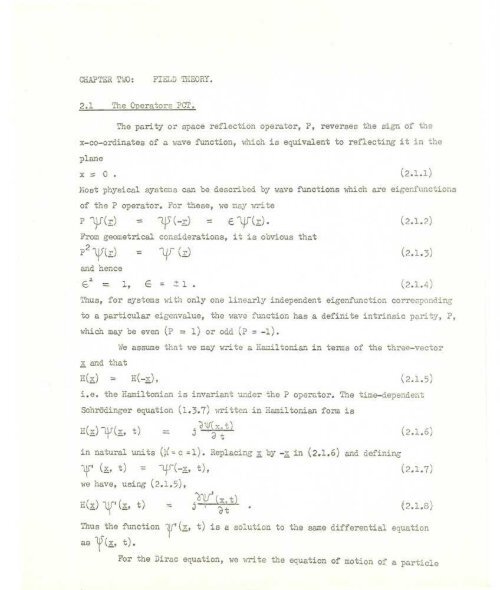introduction-weak-interaction-volume-one
introduction-weak-interaction-volume-one
introduction-weak-interaction-volume-one
You also want an ePaper? Increase the reach of your titles
YUMPU automatically turns print PDFs into web optimized ePapers that Google loves.
CHAPTER TbO : FIELD THEORY .<br />
2 .1 The Operators PCT .<br />
The parity or space reflection operator, P, reverses the sign of the<br />
x-co-ordinates of a wave function, which is equivalent to reflecting it in th e<br />
plan e<br />
x _ 0 . (2 .1 .1 )<br />
Most physical systems can be described by wave functions which are eigenfunction s<br />
of the P operator . For these, we may write<br />
P ).T(z) (-R) = E, 4r(r) . (2 .1 .2 )<br />
From geometrical considerations, it is obvious that<br />
P2 Ni(r.) _ (=) (2 .1 .3 )<br />
and henc e<br />
EZ = 1, C _ } 1 (2 .1 .4 )<br />
Thus, for systems with only <strong>one</strong> linearly independent eigenfunction correspondin g<br />
to a particular eigenvalue, the wave function has a definite intrinsic parity, P ,<br />
which may be even (P = 1) or odd (P = -1) .<br />
We assume that we may write a Hamiltonian in terms of the three-vector<br />
x and that<br />
(2 .1 .5 )<br />
i .e . the Hamiltonian is invariant under the P operator . The time-dependen t<br />
Schrddinger equation (1 .3 .7) written in Hamiltonian form i s<br />
H ( x ) 1)-(x, t ) _ jY(ox1t)<br />
(2 .1 .6 )<br />
in natural units ( = c =1) . Replacing x by -x in (2.1 .6) and defining<br />
' (x, t ) _ t ), (2 .1 .7 )<br />
we have, using (2 .1 .5) ,<br />
H(z) ~ '(x, _ t) _ J {x't )<br />
(2 .1 .8)<br />
a t<br />
Thus the function Zf'(x, t) is a solution to the same differential equatio n<br />
as 1Y(x, t) .<br />
For the Dirac equation, we write the equation of motion of a particl e



